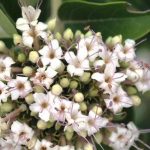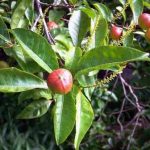TREE LIFE
June 1999
The annual subs ($80) are due. If you haven‘t already paid, please do, completing the invoice attached to April’s Tree Life, and indicate if your address has changed.
MASHONALAND CALENDAR
Saturday 5 June. Botanic Garden Walk. Our walk in the economic section continues and we will also have a look at more of the little known and seldom seen species on Mark’s list. We will meet Tom in the car park at 10.45 for 11 a.m. & there will be a guard for the cars.
Sunday 20 June. Mrs. Helen Monaghan will be our host on her farm Sivundazi, Helden Estates, in the Selous/Chegutu area. As well as her farming activities, which are many, Helen grows herbs, and although the recent heavy rains did cause some problems, the range and quantity of herbs in Helen’s herb garden is impressive as is her knowledge. In the morning we will have a bush walk, some of the unusual trees we will see are Terminalia randii (20 ft), Bolusanthus speciosus, Berchemia discolor and Synadenium sp. Lunch in the garden then Helen will show us and talk about her herbs.
Saturday 26 June. Mark’s walk this month will be to the Greystone Park Nature Reserve. Directions:
Saturday 3 July. Botanic Garden Walk.
MATABELELAND CALENDAR
Sunday 6 June. Breeze Road Waterford, where we will look at Aloes and other succulents in the garden of Anthon and Mary Ellert. Meet at their house at 8.45, or at the Girls’ College car park, Pauling Road entrance for 8.30 sharp.
EASTER AT EASTERN HIGHLANDS TEA ESTATE
Day 1 – 2 April 1999
After a comfortable night and breakfast on the verandah overlooking the Honde Valley the party of 14 boarded the two suitable vehicles to begin a weekend of botanising in the Eastern Highlands. Nothing has changed; it is still exciting, challenging and frustrating.

Macaranga capensis. Photo: Bart Wursten. Source: Flora of Zimbabwe
‘Baboons Paradise’ was our intended destination but the geography of the estate is such that it is not certain that that is where we actually spent the day. Our stop however, provided a most interesting and accessible walk along the steep sides of a valley. The general feeling was of rich forest vegetation at all levels. The ‘base camp’ was under tall trees, mainly Newtonia buchananii and Macaranga capensis. The understorey was made up almost entirely of a species of Acanthaceae – waist high and which may be the species that only flowers once in 5 years. Aframomum sp. and many ferns mostly Tetaria gemifera with babies on the leaves which when ready will drop to the moist ground to continue the cycle. A dainty Panicum grass and beautiful Selaginella sp. covered some of the available floor space.
Growing in their natural habitat the Newtonia buchananii were tall and straight bearing on their uppermost branches masses of epiphytic orchids and Zimbabwe’s only member of the cactus family – Rhipsalis baccifera which looks rather like Sarcostemma viminale. The leaves of the Eastern Highlands Newtonia are twice pinnate with hundreds of leaflets and with erect glands between each pair of pinnae. Dichrostachys has similar glands. Oxyanthus speciosus, which we recognized from visits to Ngomakurira near Harare, was fairly easy to spot, the leaves being very dark green and the stipules large.
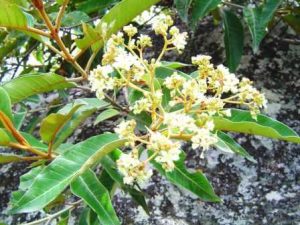
Harungana madagascariensis. Photo: Bart Wursten. Source: Flora of Zimbabwe
Harungana madagascariensis was a common tree, and at this time of the year on the ends of the branches were the dried up remains of flowers or fruit. Peddiea africana showed its green flowers and black marble size fruit on one tree and to confirm our identification, obliged by not breaking cleanly but leaving long strips of bark when picked.
Other trees which we recognized, or were able identify after checking for pointers such as the presence of glands, stellate hairs or milky latex were Chrysophyllum gorungosanum, with milk, grey/¬silvery underside to the leaves, dark and shiny upper-sides, and rather similar to another member of the Sapotaceae family – (Bequaertiodendron) Englerophytum magalismontanum. Drypetes natalensis with toothed margins to the shiny leaves and which can easily be confused with Rawsonia lucida, which was also seen. The most obvious difference being that in Drypetes the base of the leaf is markedly asymmetric. The wonderful scent of crushed Citrus limon leaves lingered for a while – we noticed at least two lemon trees on this walk and wondered how they had got there. Bridelia micrantha, Syzygium cordatum, Albizia gummifera, Ficus sur, Cussonia spicata, Rhus chirindensis, Vernonia myriantha, Myrianthus holstii, Polyscias fulva, Carissa bispinosa with forked spines, Choristylis rhamnoides, Faurea saligna and Trema orientalis were all there.
The trees were festooned with creepers such as Landolphia sp., Agelaea pentagyna, Boehmeria platyphylla a member of the nettle family Urticaceae, with long (12″-15″) strings of hooked fruits, Rutidia orientalis with strange ‘tatty spurs’ Robbie du Plessis’ apt description of the stipules, Rhoicissus rhomboidia, the climbing fern Lygodium kerstenii and the attractive Behnia reticulata.
Very little was in flower so late in the season, but Michael du Plessis found a flowering Montbretia / Coprosmia; Desmodium repandum with orange flowers favoured the shady places, and a Polygala sp. – with smaller leaves than Polygala virgata – Pride of Manicaland occurred on the slopes.
From past experience we expected to be confused by the many Rubiaceae species and we were. Samples have been pressed to show our fundis – Tom and Bob.
The great “Mystree” of the day was a tree with the most beautiful, sweet scented flowers, which resembled Oncoba spinosa.
Head scratching and reference to CP drew a blank till after lunch when a stroll along the road revealed acres of tea bushes and amusingly the answer to the puzzle.
We thank the du Plessis and Fibeck families for transporting us and Mark for leading us in such tricky habitat and providing the answers to so many of our questions.
-Maureen Silva Jones
EASTERN HIGHLANDS TEA ESTATE: DAY 2 – 3 April 1999
In the morning, our little convoy of vehicles set off from our relatively high altitude camp at the Eastern Highlands Club down through the green hillsides of tea and back on to the main road.
Near to the turn off is a nice specimen of Hymenocardia acida, the heart-fruit, which was spotted by the du Plessis’s on their arrival. We don’t very often see it and it was very nice to see this tree covered in copious fruits with their striking wings. It belongs to the Euphorbiaceae and is dioecious (obviously we had a female one here). A useful “spot” we were able to confirm is that the leaves have orange-yellow glands dotted beneath.
A short distance along this road we crossed the Nyamingura River over a strange stepped bridge and shortly after turned right into the other section of Eastern Highlands. On the maps (1:50000, compiled in 1989) this section is shown as Aberfoyle Plantations but it is not the area now called Aberfoyle which lies to the E of Eastern Highlands Tea Estates.
We aimed to get away from the river to the edge of the tea, where we hoped to find undisturbed forest. On our way up, our way was blocked by a trailer and in the short wait, some interesting herbs were found on the embankment by the road. Some are still unnamed, but one was a tiny prostrate herb new to me. It belongs to the Rubiaceae and has black berries and ovate cordate leaves: Geophila obvaliata subsp. ioides. In Zimbabwe, it is confined to the eastern districts. The closest we have got to it before is the somewhat similar Geophila repens in the Chirinda forest.
Further on, we stopped where the road ran through a moist valley and began to climb up a steep and wide, muddy firebreak. Going was difficult and the botany unrewarding so it was not surprising that a number of people dropped out and went back down while others went on ahead at a faster pace; I stayed with a group travelling at a medium speed and we eventually reached a track, which we ascended through tea and forest until we were nearly up to the edge of the Inyanga Block to the north.
A lot of plants we saw remain unidentified, but a number of things were nameable and proved of interest. One was a mysterious whippy shrub which we have seen before in the Vumba and which has defeated us in the past. It has opposite leaves and narrow interpetiolar stipules, each of which is forked into oblong segments at the apex. Here, it was seen to be a young form of a climbing Rubiaceae Mussaenda arcuata, whose yellow and orange flowers we saw quite frequently.
Common in the forest patches (and generally in the Honde Valley) was Anthocleista grandiflora, with its huge leaves rather similar to Uapaca kirkiana. Nowadays, it is very commonly planted in Harare and seems to do very well there looking very striking and flowering and producing fruit.
Also new to me was a bramble, Rubus rosifolius. It is a shrub with long unbranched stems, white flowers, pinnate leaves and red fruits. The fruits were the most striking consisting of a very large number of tiny drupelets. It is probably an introduction.
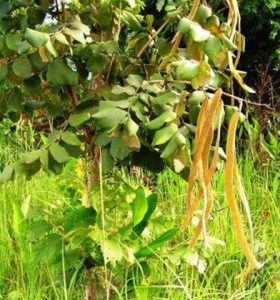
Markhamia obtusifolia. Photo: Jos Stevens. Source: Flora of Zimbabwe
Descending, we came down the steep slope on a long series of steps – hard on the knees and ankles but easier than the slippery firebreak. Near the bottom were some beautiful pods of Markhamia obtusifolia. This is the rarer of the two species which we get in Zimbabwe.
Markhamia zanzibarica is the one we generally see at medium and low altitudes with fewer pairs of leaflets and more or less glabrous, lenticellate pods. Markhamia obtusifolia has pods covered with fine golden hairs – completely different.
After our descent, we had a very late lunch seated on some logs by the side of the track. As we descended, a very spectacular specimen of the purple flowered Brillantaisia ulugurica (Acanthaceae) was seen in the forest.
-Mark Hyde
Easter Sunday 1999 Day 3. 4 April.
We had decided to spend the day at Aberfoyle. As we wended our way through the tea plantations back to the main road, we saw seven silvery-cheeked hornbills. They were feeding in the exotic Syringa (Melia azedarach). We eventually came to a beautiful waterfall, but, we’d been warned by the local residents that it was treacherous. The river was lined with magnificent trees. We confirmed Breonadia salicina. It is very like Rauvolfia caffra but has no milky sap. Albizia gummifera and Albizia adianthifolia were both seen and compared. The former with a heel on the leaflet and no hairs while the latter has rusty brown hairs on the underside of the leaves. We came across a few old friends in the forests; Erythroxylum emarginatum (lizard legs), Parinari curatellifolia (Mobola plum), Tetradenia riparia (ginger bush). We again saw our newly found friends; Newtonia buchananii and Macaranga capensis with the peltate leaves. Also Harungana madagascariensis, praying hands with velvety brown hairs on the underside of the leaves. This is the same family as Psorospermum febrifugum, Christmas berry, which we are probably more familiar with and also saw. Both belong to the Clusiaceae family. Mark noted that there was a line of black dots on the underside of the leaf margin in both species. We found the creeper Solanecio angulatus. It has composite yellow flowers, no milky sap (it looked as if it should have had!) and deeply lobed leaves with auricles at the leaf base. Dave found what looked like a fern leaf with a wined rachis. John thought it looked a bit like a Grevillea leaf. It was Filicium decipiens and we were delighted to then find an enormous tree of it later.
From Michael: “Robbie and I went to look at the waterfall. On our way back to the group I came across a little tree frog. It was the most beautiful frog I have ever seen It was small, (less than 3 cm) with a pale underside. Its legs were grey. Its back was a brilliant green with yellow spots sparsely dotted all over its back. I put it in my pocket and showed it to the rest of the Tree Society. Mr. Fibeck took a photo of it and then I let it go.”
From Robbie’s diary: “On the way we saw a beautiful one [butterfly]. We reached the waterfall that was very dangerous. It was a beautiful waterfall. We walked up a slippery path on to a higher road. Well there were butterflies everywhere and all different kinds, pansies, swallowtails, mothers of pearl and lots more.”
And after lunch on to the Aberfoyle club where the highlight for us was the excellent view of the palm-nut vulture in the palm trees along the golf course. Another enjoyable day and an enlightening weekend spent with the Tree Society. Thank you!
-The du Plessis Family.
ORCHIDS ON THE EASTERN HIGHLANDS TEA ESTATE TRIP
With approx. 350 species, orchids are not particularly rare in Zimbabwe. But it depends entirely on the type and condition of the habitat whether orchids do occur and which types of species are to be found. The Honde Valley, for example, is a subtropical high rainfall area (approx. 2500 mm annually) and such conditions are very suitable for epiphytic orchids.
Altogether 20 epiphytic species were found in these few days (see list); about half of these were recorded in more than one habitat. On the other hand, only 2 terrestrial species could be found because areas with such high rainfall favour epiphytism.
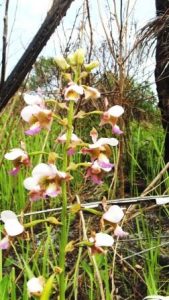
Eulophia horsfallii. Photo: Mike Bingham. Source: Flora of Zimbabwe
Possibly the most interesting find was Eulophia horsfallii growing near the club in a gum plantation. This is a large terrestrial species with a flower spike up to 2.5 metres high and 5 cm large attractive flowers; purple, brown and pink in colour and waxy in texture. Close to 100 plants were counted with many small seedlings which were growing in a jumble of discarded wooden chips containing suitable fungi as nursing aid for the minute seeds.
The habitat visited on 2.4.99 was a subtropical wet evergreen forest with a high canopy and a well developed understorey of ferns, climbers etc. About 16 species (incl. 1 terrestrial) were recorded. Orchids were more numerous in the lower wetter part of the forest because they strictly follow the water. Mature trees were sometimes covered with epiphytes, with Tridactyle tridactylites and Angraecopsis parviflora sometimes in abundance, the latter in bloom with small greenish flowers. On the other hand, Polystachya tessellata preferred a more open habitat on the drier upper slopes. More than half of the recorded species appeared to be fairly rare and were seen only once. Although the colonies were always large and healthy with no sign of impoverishment.
The second habitat (on Aberfoyle) was a beautiful tropical riverine forest, consisting of a line of mature trees which carried a considerable number of orchids and ferns. 15 species were recorded and it was observed that most species preferred to grow in an ecological niche: certain species in deep shade near the water, others persistently in the high canopy. One big fallen tree was found (with 7 species) where the distribution pattern could be studied from a closer distance: some on the main stem, others mainly in the mid canopy shade and others, e.g. Polystachya stuhlmannii and the leafless Microcoelia exilis, in the high canopy often on small branches.
List of recorded epiphytes.
Bulbophyllum encephalodes
Bulbophyllum josephii
Bulbophyllum Iongiflorum
Bulbophyllum maximum
Bulbophyllum sandersonii
Bulbophyllum unifoliatum
Polystachya albescens
Polystachya caespitifica
Polystachya stuhlmannii
Polystachya tessellata
Cyrtorchis arcuata
Cyrtorchis praetermissa
Tridactyle anthomaniaca
Tridactyle tridactylites
Angraecopsis parviflora
Diaphananthe stolzii
Jumellea filicornoides
Microcoelia exilis
Oberonia disticha
Rangaeris muscicola
Terrestrial orchids:
Eulophia horsfallii
Platylepis glandulosa
-Werner & Virginia Fibeck
Welston – 18 April 1999
This part of the Welston area is mainly mature open Miombo woodland and is where the highveld terrain begins its gradual decent towards Chinamora. Although fairly typical vegetation around the car park, an interesting variation occurs close to the stream which was the site of one of Mark’s botanical walks earlier this year.
With Mark in the lead and after some closer examination, a feature which appeared common to Acacia polyacantha, Albizia amara and Dichrostachys cinerea is that they all carry glands on the leaf rachis, the Acacia and Albizia have large and highly visible glands near the base of the leaf, while Dichrostachys have a small stalked gland with a spherical head which really requires the use of x10 lens.
For the few members of the Compositae family noted which included Tarchonanthus camphoratus, Brachylaena rotundata and Vernonia adoensis are normally easily identified by the flower structure but there seems to be a problem with Vernonia sp. as field identification is difficult due to the fact that a general key using leaves is not reliable. So, if anybody has bright ideas about identifying the various Vernonia sp. using general features, please would you pass on your information – we need it.
The stream, which is a superb spot with crystal clear water and an Eastern Districts feel, is a tributary of the nearby Mazowe River. The Holloways have made the area accessible with a large number of convenient steps cut into the steep bank and retained with short poles – this must have been quite a job. On the alluvial deposits along the waters edge there are enormous hedges of the extremely colourful orange Tithonia sp., which as an introduction have naturalised very well. The waterberry Syzygium cordatum is the dominant tree species here while in the shrub category Grewia stolzii forms thickets, its small coarse and serrated leaves a marked contrast to the large floppy leaves of Tithonia sp. Not only variety in flora down here, as Sue pointed out some fauna in the stream – a large fresh water crab delicately sifting through algae before meandering off in the curious sideways motion typical of crabs before sampling more riverine delights.
Once out of the narrow valley and back into the fringe of the Miombo woodland, the drier terrain forms a suitable habitat for Commiphora mossambicensis – the pepper leaf, Mukwa – Pterocarpus angolensis laden with ripening fruit and Diospyros kirkii – with clusters of ripening fruits which should produce a very tasty treat for anyone lucky enough to pass by at the right time. The Makoni tea bush, Fadogia ancylantha, is an erect annual with a yellow tinge to the typically Rubiaceae (the interpetiolar stipules once again) arrangement of leaves. It has been suggested as a low tech variant to the various commercially produced tea brands available from supermarkets, but its sporadic occurrence and small size doesn’t offer much competition. A comment from a previous walk some time ago also indicated making an infusion too soon from freshly picked foliage will probably cause diarrhoea. Perhaps we can slip some into an unsuspecting member’s teacup on a weekend trip and observe the results first hand.
A really picturesque place and conveniently close to town and many thanks to the Holloways for another visit. Thanks also to Mark for leading a very interesting walk.
-Andy MacNaughtan
A small white-flowered annual herb found by the track as we descended into the steep-sided valley on the visit to the Holloway’s place proved to be of interest. It was Haumaniastrum villosum, a labiate. We saw it again not far from the parking place on the short afternoon walk. It is a delicate plant, mostly no more than 20 cm tall, with conical heads from which tiny white flowers protrude. Most of the species of this genus have striking blue brats and with the tight conical heads they look like composites; however this species does not. It is a new record to the central division, but has been recorded from the northern and eastern divisions.
Another herbaceous plant, which surprised me, was Duosperma crenata (Acanthaceae), which was growing down in the moist riverine vegetation. It has creamy-yellow flowers and broad leaves which are markedly serrate (unusual in Acanthaceae) This is a common Zambezi valley species which occurs usually at lower altitudes and in much drier places; often in the shade of trees or on termite mounds and also in dry woodland.
To show that this is not an unusual occurrence we saw Duosperma again by the river at Christon Bank on the day of the AGM.
It shows that there are still lots of interesting things to be found even close to home.
-Mark Hyde
ANDY MACNAUGHTAN CHAIRMAN


